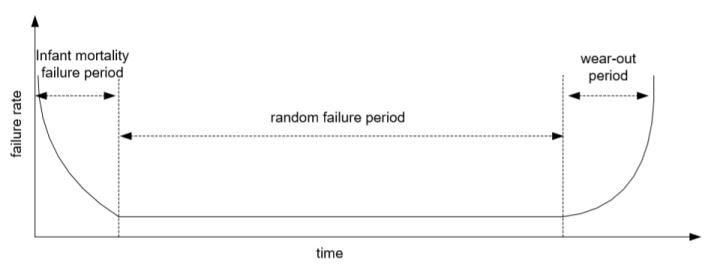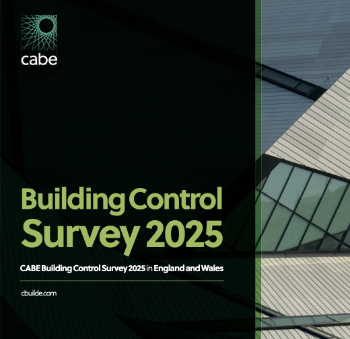Investigating failures in building services
Contents |
[edit] Introduction
A study from the UCL(1) revealed that building failures may cost the UK construction industry £1bn to £2bn every year. This was a conservative estimate made in 2016, based on 1 to 2% of the total value of construction.
As of March 2020, the Office for National Statistics has estimated the total value of all UK construction works to be worth £12.7bn, 68% of which is for new buildings or the repair and maintenance of existing buildings. This would give an estimated cost of failure between £85m and £170m, of which building services would account for a high proportion.
[edit] Types of failures in building services
Diagram courtesy of BSRIA; not for reuse.
The typical pattern of failure arising against time is shown by the well-known bathtub curve, which is divided into three segments or periods.
The first period is usually detected during the defects liability period after a project is handed over.
The second period would happen during the operation of a system, and failures may occur due to inappropriate operating conditions or maintenance regimes.
The third period is when the system is reaching the end of its life. Failure could be imminent and there should be little or no surprise in this happening.
[edit] Importance of investigating these failures
There are various reasons why every unexpected failure should be investigated. Below are some of the key ones:
- Insurance purposes. Insurers may require an independent evaluation of the failure and investigation of its possible cause to identify possible fraudulent or malicious intentions.
- Cost savings. Too often, failed components are replaced without investigating the root cause. Without understanding the origin of a failure, it is not possible to prevent its re-occurrence. Repetitive failure and replacement of components could add significantly to the operating cost for a building or estate.
- Health and safety. In May 2009, a lift at London’s Tower Bridge tourist attraction suffered a vital mechanism failure that sent it falling with nine people in it, four of whom suffered bone fractures. The malfunction was caused by the failure of a counterweight mechanism. The accident investigation by the HSE revealed that there had been several previous component failures with the counterweight mechanism, and the components had been replaced without proper review, and with no investigation into why they were failing so early. Tower Bridge was ordered to pay a total cost of £100k, and the HSE concluded that, had there been a proper review into the counterweight mechanisms, the catastrophic failure of the lift could have been avoided.
Read more about BSRIA’s Failure Investigation service here.
(1) Razak, D S A, Mills, G and Roberts, A (2016) External Failure Cost in Construction Supply Chains. In: P W Chan and C J Neilson (Eds.)
This article was originally published as The importance of investigating failures in building services on the BSRIA website on 20 May 2020. It was written by Martin Ronceray, BSRIA Engineering Investigation Lead.
--BSRIA
[edit] Related articles on Designing Buildings Wiki
- BSRIA articles on Designing Buildings Wiki.
- Cracking and building movement.
- Defects.
- Failure.
- Failure modes and effect analysis (FMEA).
- Inspection and test plan.
- Latent defects.
- Structural failures.
- Why should quality be important to the construction industry/
Featured articles and news
PPN 021: Payment Spot Checks in Public Sub-Contracts
Published following consultation and influence from ECA.
Difficult Sites: Architecture Against the Odds
Free exhibition at the RIBA Architecture Gallery until 31 May.
Designing Buildings reaches 20,000 articles
We take a look back at some of the stranger contributions.
Lessons learned from other industries.
The Buildings of the Malting Industry. Book review.
Conserving places with climate resilience in mind.
Combating burnout.
The 5 elements of seiri, seiton, seiso, seiketsu and shitsuke.
Shading for housing, a design guide
A look back at embedding a new culture of shading.
The Architectural Technology Awards
The AT Awards 2025 are open for entries!
ECA Blueprint for Electrification
The 'mosaic of interconnected challenges' and how to deliver the UK’s Transition to Clean Power.
Grenfell Tower Principal Contractor Award notice
Tower repair and maintenance contractor announced as demolition contractor.
Passivhaus social homes benefit from heat pump service
Sixteen new homes designed and built to achieve Passivhaus constructed in Dumfries & Galloway.
CABE Publishes Results of 2025 Building Control Survey
Concern over lack of understanding of how roles have changed since the introduction of the BSA 2022.
British Architectural Sculpture 1851-1951
A rich heritage of decorative and figurative sculpture. Book review.
A programme to tackle the lack of diversity.

























